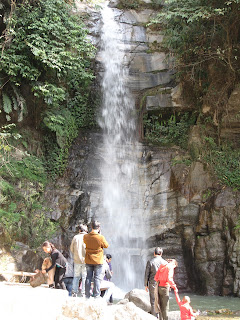Earlier this month on 4th Feb, we set out on a 8D/7N trip to Sikkim and Darjeeling. Starting our journey at 5 in the morning from Bangalore, changing flights at Delhi, we finally arrived in Bagdogra, West Bengal, at 1:45 pm after almost 9 hours. Our first destination was Gangtok in North Sikkim. The distance between Bagdogra and Gangtok was only 125 km, but the roads were so bad that it took us four hours to reach Gangtok. We had lunch at a small dhaba in Bagdogra and started our journey by road at 3pm. While the weather was warm in Bagdogra, the temperatures started to fall as we went up closer towards Gangtok. By the time we arrived in Gangtok at around 7 pm, the temperature was around 12 degrees. We checked into our rooms at Ttakshang Residency, had dinner, and called it an early night. Overnight, the temperatures dipped to 2 degrees but the hotel staff were very courteous and did everything to make our stay comfortable.
Next morning, covered in winter clothes, caps, gloves etc, we set out for local sightseeing. The local tour guides offer a full-day sightseeing covering 10 points or 7 points. It is usually between 9 am and 5 pm. Our first stop was Rumtek Monastery which was a one-hour drive from Gangtok. Built in the 16th century, it is the oldest Tibetan Buddhist Monastery in Gangtok. You can read more about it here. The monastery is a steep walk of nearly a km from the parking lot. So wear comfortable shoes to make it easier to climb up the slopes.
Next morning, covered in winter clothes, caps, gloves etc, we set out for local sightseeing. The local tour guides offer a full-day sightseeing covering 10 points or 7 points. It is usually between 9 am and 5 pm. Our first stop was Rumtek Monastery which was a one-hour drive from Gangtok. Built in the 16th century, it is the oldest Tibetan Buddhist Monastery in Gangtok. You can read more about it here. The monastery is a steep walk of nearly a km from the parking lot. So wear comfortable shoes to make it easier to climb up the slopes.
After offering our prayers at the monastery, we set out to our next stop, the Banjhakri Falls and Energy Park.
 |
| BanJhakri Falls |
Spread over nearly two acres, this energy park makes most of the abundant water available to produce power and this power helps to light the entire park including the cafeteria. Enchanting gazebos and foot bridges make this an interesting place to visit.
After lunch at the cafeteria at Banjhakri Falls, we set out for our next destination, Ganesh Tok. Perched on a hill top, Ganesh Tok has a little Ganesh Mandir and offers a panoramic view of the entire region. Here, there were stalls offering traditional Sikkimese outfits for the tourists to dress up in. We all enjoyed dressing up as the locals and took a lot of photos posing in them.
 |
| My husband and me dressed in traditional Sikkim outfits |
Our next stop was at Tashi View Point, a steep climb up, which gave a panoramic view of the mighty Kachenzdonga, the highest peak in India and the third highest in the world.
There's one more prominent view point, called the Hanuman Tok, which is under the military control. Since the roads leading to it were bad, we decided to skip it.
Later we visited the Gangtok Flower Show, a greenhouse which housed hundreds of beautiful orchids and other flowers. Orchid bulbs were available for sale too.
There are other sights worth seeing in Gangtok, like the Ranka Monastery, Dro-dul Chorten, Institute of Tibetology, but since we were seeing all these places at a leisurely pace, we couldn't cover them all.
We returned to our hotel rooms by early evening and after freshening up, we walked down to M.G. Road, the shopping hub of Gangtok.
M.G. Road of Gangtok was unlike any other M.G. Road I have come across in India. The paved road was closed to traffic, and potted plants and benches were placed along the middle of the road where people could sit and relax. The street was so clean, it would not be wrong to call it the cleanest street in India. In fact, we felt as if we were inside a mall rather than on the roadside. The entire stretch is dotted with quaint little eateries, sweetmeat shops, gift stores and shops selling woollen clothes. It is a great place to spend an evening, enjoying the cool weather.
Tips:
1. Carry thermal wear as the Feb weather was a tad bit too cold for us, ranging between 12-2 degrees centigrade.
2. Roads are very bad, so those with motion sickness are advised to carry medicines to be comfortable during travel.
3. Wear proper walking shoes as these hill stations have lot of slopes and steep walks to be covered on foot.
4. Food is mainly vegetarian as the culture is predominantly Buddhist. But nonveg options are also available.





